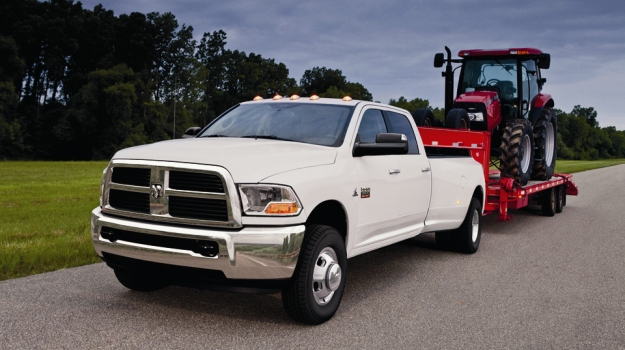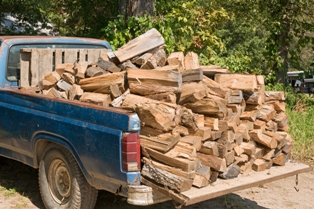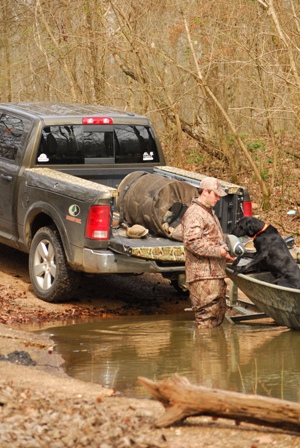
Getting the Most from Your Towing Vehicles & Trailers
By Colin Williams
For many of us, maintaining our hunting properties demands using our vehicles to tow and haul various loads and trailers. Whether it’s towing a trailer of ATVs, hauling a load of fertilizer or pulling a heavy duty load like a utility tractor, understanding the limitations of your trailer and your tow vehicle will do much to ensure safe usage. While towing a trailer seems simple enough, it’s no small undertaking, especially when lugging heavy loads or precious cargo.
In towing, weight is everything. You must know how much your tow vehicle weighs, how much your trailer(s) weigh and the total combined weight of the truck and trailer together. There are maximum weight ratings for the tow vehicle and trailer separately and a weight rating for the tow vehicle combining both, the trailer and vehicle. All of these weight ratings need to be considered together to ensure safe hauling.
It’s a great idea to establish a relationship with your local farm elevator. These places typically have scales used for weighing incoming and outgoing grain trucks and if you schedule your visits outside of when the local farmers are harvesting their cash-crops they may just help you determine the weight of your vehicle, trailer, the loaded weight of the two together and if you ask nicely maybe also the tongue weight.
TRAILER WEIGHT
Once you determine what you need in trailer, you then need to know the trailer weight. Each commercially manufactured trailer has a VIN plate installed somewhere on the main frame. This plate will list the trailer’s unloaded Gross Vehicle Weight (GVW) as well as the Gross Vehicle Weight Rating (GVWR). These numbers are important. The GVW simply tells you how much the trailer itself weights, and the GVWR tells you how much weight the trailer can safely haul.
For example:
Depending on manufacturer and design a common 6X10 enclosed trailer has a GVW (or sometimes referred to as “empty weight,” or “curb weight” on a trailer) of 1,050 pounds. The GVWR is 2,990 pounds. This means the trailer has a cargo capacity of 1,940 pounds. (2,990 - 1,050 = 1,940)
TOW VEHICLE
Your tow vehicle also has a GVW (Gross Vehicle Weight), which again is the standard weight of the vehicle. Depending on the manufacturer, the GVW may include an allowance for a common amount of additional weight including passengers and gasoline. Some manufacturers will describe the GVW for their vehicles as the “curb weight.” Based on that fact alone, it would be best to weigh your vehicle to establish a solid starting point for your vehicle’s GVW. If you have added any aftermarket parts, like a topper for example, your tow vehicle listed GVW will not be correct anyway.
 Similar to your trailer, your tow vehicle will also have a (GVWR) Gross Vehicle Weight Rating. This is the actual safe maximum weight of your vehicle and everything you haul including passengers and anything in the bed of the pickup. If you exceed this weight, it could stress such components as the transmission and brakes.
Similar to your trailer, your tow vehicle will also have a (GVWR) Gross Vehicle Weight Rating. This is the actual safe maximum weight of your vehicle and everything you haul including passengers and anything in the bed of the pickup. If you exceed this weight, it could stress such components as the transmission and brakes.
Another rating you will need to know about your tow vehicle is the Gross Combination Weight Rating (GCWR). This is the maximum weight of your vehicle and trailer combined. You need to include not only the weight of the trailer and tow vehicle, but also the implement you are hauling, people or anything added to the payload of the truck. If the weight of both your trailer and vehicle combined exceeds this rating, you will be stressing your vehicle beyond design limitations. This weight rating can be found either on the sticker located on the door sill of the driver’s side door, in your owner’s manual, you can look it up online, or if all else fails, pull the VIN number and contact the manufacturer.
In order to better understand manufacture ratings and tow requirements, I spoke with Luke Marsh, Research and Development Engineer with Ram Truck Brand. “The first thing you need to understand,” said Marsh, “is a pickup will have a wide range of trailer towing weight capability depending on cab configuration, engine, axle ratios, transmission, springs, frame and other added options. Each 2500 series Ram truck has a standard vehicle weight,” Marsh added. “When you chose a crew cab over a regular cab for example, additional weight is added to the standard vehicle weight which will then reduce the amount of weight allowable for payload and towing.”
When it comes to weight and towing, Marsh said the Gross Combined Weight Rating (GCWR) is calculated based on 20% of the trailer weight on the gooseneck or fifth wheel, and 10% on the bumper or hitch type trailers. “Payload capacity is determined after knowing how much your truck weighs with all the added options,” said Marsh. “As the payload amount widely varies, so then do the limits for trailer load capacity.”
Other truck options make a difference in towing as well, such as axle ratios. “Ram trucks currently come in a variety of axle ratios ranging from a 3:42 on the lower end and a 4:0 on the upper end,” explained Marsh “The 3:42 will generally provide better fuel economy and lower engine nose, but because the engine is turning a lower RPM you have less available horsepower for towing.” “Conversely,” Marsh added, “the 4:10 axe ratio will increase towing power and acceleration, but the fuel economy may suffer. It is important to know what your towing needs will be as you can do quite a bit more with a 3:42 axle than you might think.”
When you compare the towing capability of the 2012 Ram 1,500 4.7L V8 Quad Cab SLT with a 2012 Ram 1,500 Standard Cab SLT both, with a 3.55 axle ratio, the quad cab has GVWR of 6,700 pounds and a max trailer weight of 5,750 pounds. The Standard cab has a GVWR of 6,500 pounds and a max trailer weight of 6,200 pounds. The notable difference in the amount they can tow has everything to do with the additional option of a quad cab adding additional weight to the base weight of the vehicle, thus reducing the amount of total trailer you can tow.
Every truck manufacturer has carefully determined towing capacity ratings following federal guidelines. Therefore you can rate a truck on what it will pull and you’ll be “comparing apples to apples.” However, there are no requirements to design brakes beyond the truck GVW. “When researching your truck purchase, or evaluating towing safety in your current tow vehicle,” cautioned Marsh, “brakes need to be considered. With manufactures designing trucks for towing in mind and employing bigger frames, more torque and bigger axles, don’t forget to consider brakes when researching your tow vehicle.”
THE HITCH
 You could very easily have purchased a used tow vehicle which has the towing capacity for a 7,500 pound loaded trailer. Did you take a good look at the hitch? It’s possible the truck may only have a hitch installed rated for 3,500 pounds. You may have a trailer capable of handling the weight and a truck capable of pulling it, but the hitch may not come close to being able to do the job
You could very easily have purchased a used tow vehicle which has the towing capacity for a 7,500 pound loaded trailer. Did you take a good look at the hitch? It’s possible the truck may only have a hitch installed rated for 3,500 pounds. You may have a trailer capable of handling the weight and a truck capable of pulling it, but the hitch may not come close to being able to do the job
Keith Brunett, Technical Services Manager with CURT Manufacturing, specializes in towing and hitches. “Choosing the correct hitch is based first on the vehicle and second what you will be towing,” said Brunett. “The vehicle must first have the towing capacity for the type of hitch installed and the gross trailer weight and tongue weight will then determine which hitch you will need.” Again it all centers around weight – and all the pieces must fit together.
The most common hitches today are receiver hitches. These hitches are manufactured in basically five different classes. The class 1 and 2 hitches are light duty receivers made for passenger cars and small SUV’s. Class 1 hitches can handle up to 2,000 pounds of trailer and a Class 2 can go up to 3,500 pounds of loaded trailer. Class 3 hitches are the most popular installed in full-size pickups and can handle up to 8,000 pounds. Class 4 hitches will go up to 12,000 pounds and class 5 can get you up to 18,000 pounds with proper weight distribution hitch attachments.
PUTTING IT TOGETHER
Say for example you have a Polaris Ranger that you use for fencing and farm work which demands hauling occasionally. Rangers run about 1,200 to 1,500 pounds. You will likely need a 6 X10 trailer to accommodate an implement of this size. Depending on trailer manufacturer and style, an aluminum enclosed trailer has a GVW of around 1,150 pounds and a GVWR of 2,990. This trailer, loaded with your Ranger would weight about 2,600 pounds. So this demands a vehicle that can tow 2,600 pounds and a class 2 hitch.
If you’re farm demands the use of a skid loader, a trailer that size should have a minimum load rating of 6,000 pounds. The total GVWR with the trailer and skid loader would have a minimum weight of nothing short of 7,000 pounds and they go up from there depending on the size of the trailer. So using a total trailer GVWR weight of 7,000 pounds your vehicle must have the towing capacity for 7,000 pounds and the hitch will need to be at least a class 3.
TONGUE WEIGHT
Another factor important to safe trailering is tongue weight. Tongue weight is the weight at the coupler when your trailer is fully loaded ready to go. The general rule of thumb is you want between 9% and 15% of the total trailer weight to be carried on the tongue. Too much tongue weight and the coupler between the tow vehicle and trailer will sag and the tow vehicle will work much harder to pull and stop the load. Too little tongue weight will create a trailer heavy on the back end thus resulting in sway and too much weight on the tires. You can measure your tongue weight on a commercial scale by just getting on the scale enough so the tongue weight is the only thing weighed. Be sure to set the coupler at the towing height of the vehicle.
According to Keith Brunett, when determining tongue weight if you discover the weight is either too light or too heavy there are simple adjustments you can make if you’re trailer load capacity is within manufacturers weight restrictions. “The axle is the center-point of the trailer,” said Brunett. “If the tongue weight is too low the load can simply be slid forward of the axle to put more weight on the tongue, and if the tongue weight is too heavy, you should slide your load back further over the axle.”
Before hauling you’re ATVs to the farm, or even hauling a trailer load of fertilizer or seed, it is well worth your time to take your trailer down to your local elevator and get these weights:
- The weight of your tow vehicle, preferably loaded - and be sure the weight is less than the vehicles GVWR.
- The weight of the loaded trailer alone to be sure the loaded weight is less than the trailer GVWR.
- The weight of both the loaded trailer and vehicle to ensure the weight is less than the vehicle GCWR
- Then get the tongue weight and be sure the tongue weight is between 9 and 15 percent of the loaded trailer weight.
- Also be sure your trailer hitch is rated for the weight you are towing.
Pulling a trailer safely must always be the foremost consideration. Learning how to drive with a trailer is an acquired skill but you can move forward confidently once you know your tow vehicle, trailer and trailer hitch are the right fit.
Photo credit, truck hauling wood: Ken Cole | Dreamstime.com



























